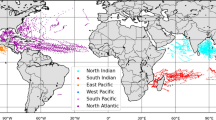Abstract
Coastal regions in India are very frequently hit by Tropical Cyclones (TCs), which result in tremendous loss. Its intensity prediction has been a challenging task because of drastic climatic changes over the past few years in the world. Intensity of Tropical Cyclone is highly influenced by ocean, atmospheric and meteorological parameters which makes the task difficult to define the mechanism of Tropical Cyclone intensity prediction. Here, a hybrid deep learning model is built using historical observations collected from various sources to perform a data-driven prediction of Tropical Cyclone’s intensity using regression model. This hybrid model utilizes convolutional neural network (CNN) architectures for feature extraction and machine learning models for regression. The hyper-parameters are optimized to fine-tune the model. The weights and biases are optimized using stochastic gradient descent (SGD). The proposed system is also compared with other regression models in machine learning and deep learning. The spatial analysis is accomplished using Modern-Era Retrospective analysis for Research and Applications, Version 2 Project Overview (MERRA-2) data for various coastal regions that are hit by cyclones. The temporal analysis is carried out using intensity skill forecast for time-series observation. The proposed system is also tested for Cyclone Amphan that hit eastern coastal regions of India.












Similar content being viewed by others
References
Baik J J and Hwang H S 1998 Tropical cyclone intensity prediction using regression method and neural network; J. Meteorol. Soc. Japan 76(5) 711–717.
Buranasing A and Prayote A 2014 Storm intensity estimation using symbolic aggregate approximation and artificial neural network; International Computer Science and Engineering Conference (ICSEC 2014: International Track Khon Kaen, Thailand).
Chen B, Chen B F and Lin H T 2018 Rotation-blended CNNs on a new open dataset for tropical cyclone image-to-intensity regression; Proceedings of the 24th ACM SIGKDD International Conference on Knowledge Discovery & Data Mining, pp. 90–99.
Chen B F, Chen B, Lin H T and Elsberry R L 2019 Estimating tropical cyclone intensity by satellite imagery utilizing convolutional neural networks; Wea. Forecasting 34(2) 447–465.
Combinido J S, Mendoza J R and Aborot J 2018 A convolutional neural network approach for estimating tropical cyclone intensity using satellite-based infrared images; 24th International Conference on Pattern Recognition (ICPR), pp. 1474–1480.
DeMaria M and Kaplan J 1994 A statistical hurricane intensity prediction scheme (ships) for the Atlantic basin; Wea. Forecasting 9 209–220.
DeMaria M, Mainelli M, Shay L, Knaff J and Kaplan J 2005 Futher improvements to the statistical hurricane intensity prediction scheme (ships); Wea. Forecasting 20 531–543.
Deo R V, Chandra R and Sharma A 2017 Stacked transfer learning for tropical cyclone intensity prediction; arXiv preprint arXiv:1708.06539.
Dvorak V 1975 Tropical cyclone intensity analysis and forecasting from satellite imagery; Mon. Wea. Rev. 103 420–430.
Fritz S, Hubert L and Timchalk A 1966 Some inferences from satellite pictures of tropical disturbances; Mon. Wea. Rev. 94 231–236.
Jarvinen B R and Neumann C J 1979 Statistical forecasts of tropical cyclone intensity; NOAA Techonological Memorandum (NWS NHC10), 22p.
Knaff J and Sampson C 2009 Southern hemisphere tropical cyclone intensity forecast methods used at the joint typhoon warning center. Part II: Statistical-dynamical forecasts; Austr. Meteorol. Oceanogr. J. 58 9–18.
Knaff J A, DeMaria M, Sampson C R and Gross J M 2003 Statistical five-day tropical cyclone intensity forecasts derived from climatology and persistence; Wea. Forecasting 18 80–92.
Knutson T, McBride J, Chan J, Emanuel K, Holland G, Landsea C, Held I, Kossin J P, Srivastava A and Sugi M 2010 Tropical cyclones and climate change; Nat. Geosci. 3 157–163.
Maskey M et al. 2018 "Tropical cyclone intensity estimation using deep convolutional neural networks." Conference on Hurricanes and Tropical Meterology. No. MSFC-E-DAA-TN54671.
Pradhan R, Aygun R S, Maskey M, Ramachandran R and Cecil D J 2017 Tropical cyclone intensity estimation using a deep convolutional neural network; IEEE Trans. Image Process. 27(2) 692–702.
Robert W Fett 1966 Upper-level structure of the formative tropical cyclone; Mon. Wea. Rev. 94 9–18.
Venkatesan R, Shamji V R, Latha G, Simi Mathew, Rao R R, Arul Muthiah M and Atmanand M A 2013 New in-situ ocean subsurface time series measurements from OMNI buoy network in the Bay of Bengal; Curr. Sci. 104(9) 1166–1177.
Vineet Kumar Singh and Roxy M K 2022 A review of ocean-atmosphere interactions during tropical cyclones in the north Indian Ocean; J. Earth-Sci. Rev. 226 103967.
Wang W and Wang X 2020 The prediction method of tropical cyclone intensity change based on deep learning; Water 12(10) 2685, https://doi.org/10.3390/w12102685.
Wimmers A, Velden C and Cossuth J H 2019 Using deep learning to estimate tropical cyclone intensity from satellite passive microwave imagery; Mon. Wea. Rev. 147(6) 2261–2282.
Acknowledgements
We thank Ministry of Earth Sciences, Government of India and Director, NIOT for their support and encouragement.
Author information
Authors and Affiliations
Contributions
VP performed the conceptualization, supervision, project administration, writing, reviewing, and editing. VN performed the data curation and formal analysis and wrote the original draft. VR performed the investigation.
Corresponding author
Additional information
Communicated by P A Francis
Rights and permissions
About this article
Cite this article
Varalakshmi, P., Vasumathi, N. & Venkatesan, R. Tropical Cyclone intensity prediction based on hybrid learning techniques. J Earth Syst Sci 132, 28 (2023). https://doi.org/10.1007/s12040-022-02042-5
Received:
Revised:
Accepted:
Published:
DOI: https://doi.org/10.1007/s12040-022-02042-5




